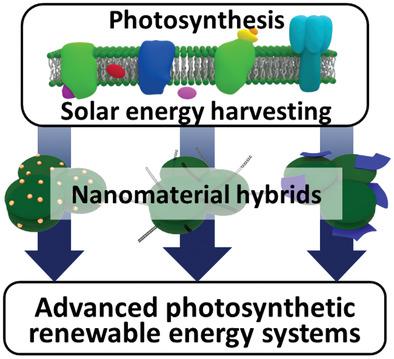当前位置:
X-MOL 学术
›
Adv. Mater.
›
论文详情
Our official English website, www.x-mol.net, welcomes your feedback! (Note: you will need to create a separate account there.)
Photosynthetic Nanomaterial Hybrids for Bioelectricity and Renewable Energy Systems
Advanced Materials ( IF 29.4 ) Pub Date : 2020-11-25 , DOI: 10.1002/adma.202005919 Yong Jae Kim 1 , Hyeonaug Hong 1 , JaeHyoung Yun 1 , Seon Il Kim 1 , Ho Yun Jung 1 , WonHyoung Ryu 1
Advanced Materials ( IF 29.4 ) Pub Date : 2020-11-25 , DOI: 10.1002/adma.202005919 Yong Jae Kim 1 , Hyeonaug Hong 1 , JaeHyoung Yun 1 , Seon Il Kim 1 , Ho Yun Jung 1 , WonHyoung Ryu 1
Affiliation

|
Harvesting solar energy in the form of electricity from the photosynthesis of plants, algal cells, and bacteria has been researched as the most environment-friendly renewable energy technology in the last decade. The primary challenge has been the engineering of electrochemical interfacing with photosynthetic apparatuses, organelles, or whole cells. However, with the aid of low-dimensional nanomaterials, there have been many advances, including enhanced photon absorption, increased generation of photosynthetic electrons (PEs), and more efficient transfer of PEs to electrodes. These advances have demonstrated the possibility for the technology to advance to a new level. In this article, the fundamentals of photosynthesis are introduced. How PE harvesting systems have improved concerning solar energy absorption, PE production, and PE collection by electrodes is discussed. The review focuses on how different kinds of nanomaterials are applied and function in interfacing with photosynthetic materials for enhanced PE harvesting. Finally, the review analyzes how the performance of PE harvesting and stand-alone systems have evolved so far and its future prospects.
中文翻译:

用于生物电和可再生能源系统的光合纳米材料混合物
从植物、藻类细胞和细菌的光合作用中以电能的形式收集太阳能已被研究为过去十年中最环保的可再生能源技术。主要挑战是与光合装置、细胞器或整个细胞的电化学接口工程。然而,在低维纳米材料的帮助下,已经取得了许多进展,包括增强光子吸收、增加光合电子(PEs)的产生以及更有效地将PEs转移到电极上。这些进步证明了该技术有可能提升到一个新的水平。本文介绍了光合作用的基本原理。PE 收集系统如何改进太阳能吸收、PE 生产、讨论了电极收集PE。这篇综述的重点是如何应用不同种类的纳米材料以及如何与光合材料连接以增强 PE 收获。最后,该评论分析了迄今为止 PE 收获和独立系统的性能如何演变及其未来前景。
更新日期:2020-11-25
中文翻译:

用于生物电和可再生能源系统的光合纳米材料混合物
从植物、藻类细胞和细菌的光合作用中以电能的形式收集太阳能已被研究为过去十年中最环保的可再生能源技术。主要挑战是与光合装置、细胞器或整个细胞的电化学接口工程。然而,在低维纳米材料的帮助下,已经取得了许多进展,包括增强光子吸收、增加光合电子(PEs)的产生以及更有效地将PEs转移到电极上。这些进步证明了该技术有可能提升到一个新的水平。本文介绍了光合作用的基本原理。PE 收集系统如何改进太阳能吸收、PE 生产、讨论了电极收集PE。这篇综述的重点是如何应用不同种类的纳米材料以及如何与光合材料连接以增强 PE 收获。最后,该评论分析了迄今为止 PE 收获和独立系统的性能如何演变及其未来前景。



























 京公网安备 11010802027423号
京公网安备 11010802027423号